Following Around the World in 80 Dishes part 1/2, we’re happy to bring you the second and final part of these series, featuring some of the most representative dishes from different regions around the world.
Reading the comments left on the first part of the article, I was happy to realize that food continues to be one of the great sources of inspiration and cultural exploration during many people’s travels. I am also proud that most of the dishes mentioned in the series are down-to-earth foods, that most people would be able to come across or afford in each country (some of the submissions even include photos of home-made goodies). Food should be a straight forward affair, accessible to all who are hungry, that is, ALL OF US!
It feels great to share this space with fellow food lovers, who take the simple things in life and make them meaningful and special.
They say you shouldn’t talk with your mouth full, so I’ll just stop the speech, because 40 dishes from around the world are about to be served!
Laughter is brightest where food is best!
41. Portugal: Arroz de Marisco (Seafood Rice)
Nothing boasts more Portugal, more Sea, for Mediterranean flavours than a steaming “just off the stove” pot of Portuguese Seafood Rice.
It is my all-time favourite dish of the Portuguese Culinary selection, and one which I regularly cook for friends as a way to show them what Portugal is all about. For me this Portuguese Seafood Rice recipe is all about using seafood that actually tastes like the sea, and the absolute base of every Portuguese stew; organic onions, garlic, chillies, peppers and bay leaf. This is what I love more about Portuguese cuisine, it is simple, yet not plain. It is unpretentious and humble enough to bring family and friends together for a celebration of food. With a handful of accessible ingredients, one can achieve tremendous depth of flavour without having to spend endless hours in the kitchen, or spending a fortune on exotic ingredients.
Remember that this dish is meant to be eaten, straight away, with some stock still bubbling in the pot when you bring it to the table.
By Nelson Carvalheiro from NelsonCarvalheiro.com
42. Russia: Pad Shooboy
This festive-looking dish is a famous Russian salad called pad shooboy which literally translates as “under the fur coat”. The essential ingredient here is salted herring that’s hiding under a thick fur coat of fresh onions, boiled eggs and cooked veggies – potatoes, carrots and beets. Beets are what give the salad this bright purple color.
All ingredients are cut into tiny pieces or graded and are organized in layers, softened and bound by another essential ingredient – mayonnaise. You may have not known this about Russian cuisine, but it uses enormous amounts of mayo. From hearty and very filling salads to baked meat – we love our mayo and add it to everything. That’s why Russia is the largest producer and consumer of mayonnaise in the world. Between multiple brands and the variety of additives, there are literally dozens of options of mayonnaise one may come across in a store: olive, paprika, lemon, dill and classic flavours – just to name a few.
Because it takes over four hours from start to finish to make this dish, it is usually prepared only for special occasions – New Year’s celebration being one of them. I can’t think of a year that we’ve skipped this tradition in my family. Living in Toronto now, I’m willing to drive for an hour one way just to get all the right ingredients from a Russian store. The salad in the pictures is my 2014 edition.
By Irina from Trips That Work
43. Malaysia: Laksa
When it comes to a country as ethnically diverse as Malaysia, choosing one representative dish is no easy task. With Chinese, Indian, and Malay populations, each with their own cuisine (not to mention some interesting fusion dishes), it’s hard to select one dish without feeling like you’re neglecting 99% of what dining in Malaysia has to offer.
Caveats aside, if you only have the time or stomach space for one dish in the culinary melting pot that is Malaysia, you’d better make it laksa. A hearty and incredibly flavorful soup that resulted from the marriage of Malay and Chinese cooking, there are actually two versions of the dish. Baba laksa is more common in the southern portion of the country and features a spicy curry broth whose heat is tempered by the rich sweetness of coconut milk; asam laksa rules the north and involves a fish broth accented by sour tamarind notes and is reminiscent of a Thai tom yum soup. Where baba laksa is creamy and decadent, asam laksa is lighter and brighter on the palate. Common ingredients in baba laksa are fried cubes of tofu, shrimp, cockles (like little clams), and sometimes even egg. Asam laksa tends to involve chunks of fish and pieces of seafood, pineapple, cucumber and other vegetables. Thick, slippery rice noodles are found in both, but beyond that, the contents of every bowl of laksa wind up being something of a surprise meaning you’ll never get bored with it.
As for which laksa is superior, that really depends on who you ask! We recommend trying them both and deciding for yourself… this is one dining dilemma where whatever you choose, the results are guaranteed to be delicious!
By Steph & Tony from 20 Years Hence
44. Albania: Tave Kosi
Like much of the Balkans, Albania’s cuisine is heavily influenced by Turkey as well as their Mediterranean location.
You can often find regional dishes like moussaka, stuffed tomatoes, qofte (meatballs), yoghurt dip (like tzatziki) and Greek salad on the menu. But there are some dishes unique to Albania, fergese for one which is a popular side dish made from roasted capsicum and a type of cottage cheese known as gjize.
One of Albania’s most unique dishes is tave kosi, a slow cooked lamb dish baked in yoghurt. The dish originates from the central Albanian city of Elbasan but is popular throughout the country. It may not look like the most appetizing dish you’ve ever seen but the tender, melt in your mouth lamb is one of the most flavoursome dishes in Albanian cuisine. It’s the kind of dish the locals like to share with guests and it can be found on the menu of most traditional Albanian restaurants.
By Andrea Anastasakis from Rear View Mirror
45. Italy: Italian Stuffed Courgette
This dish is very popular in the whole of Italy but in each region it’s done differently with some variations in the stuffing. Stuffed courgette is a very old regional recipe that stems from the rural and traditional culture in common use in families, this recipe was often imitated and varied, as each family, reworked it by putting their own touch.
The one in the photo is a vegetarian version from Puglia in the South of Italy. It isn’t an overly complicated dish, but very tasty in its simplicity and definitely moreish, in fact it’s hard to stop from eating them one after the other. The zucchini are stuffed with their own flesh combined with grated Parmigiano cheese, egg, spices, mozzarella, capers and bread crumbs I like to add some pine nuts too if I have them in the kitchen. The stuffed courgette are then baked with some olive oil, fresh chopped tomatoes and a few more capers.
There are vegan variations of this delicious dish without cheese and egg and also some meaty ones too with either mince meat or anchovies and tuna in the stuffing. My favourite is the simple one from Puglia. This dish can be eaten as a starter if you want just a little taste or as a main course, you just have to have more of it ;)
By Franca from AngloItalian Follow Us
46. Peru: Ceviche
Spawned in pre-Colombian Perú, ceviche is the classic Peruvian plate. This almost raw fish and seafood medley has spread to most of Latin America and into the US, while recently gaining notoriety worldwide.
In gastronomy circles, it’s usually agreed that Perú has the most sophisticated cuisine in South America. Many even say it’s the best on earth. In the two biggest cities, Lima and Arequipa, you can’t help but notice culinary schools as you walk the streets. A ceviche street seller on the north coast told me that she gets up at 4 am daily to make her ceviche. She’s out around 7 and typically sold out by 11. Peruvians will tell you to eat this marine mixture as early in the day as possible. If it loses its freshness, you can get sick. A general rule is to eat it before noon.
The ceviche above is from a stand outside of the San Camilo market in Arequipa, three hours from the country’s south pacific coast.
As in the photo, ceviche is often served with camote or Peruvian sweet potato, canchas or corn nuts, fresh onions, and aji, Peru’s version of a flavor-packed spicy, hot pepper. The liquid under the ceviche is leche de tigre or tiger’s milk. It’s sometimes served in a shot glass and is believed to have phenomenal health benefits.
What I like to call the cousin of sushi, ceviche calls for marinating sushi quality fish and seafood in lime juice, usually for two to three hours. The citrus juice partially or fully cooks the fish depending on how long it’s marinated. This makes the fish firm.
This entire dish comes from Peru’s unique and diverse soil and ocean. Eating ceviche is a fresh and nourishing way to enhance your morning.
By Michael Green from Earthdrifter’s
47. India: Aloo Paratha
This everyday unleavened Indian flat bread is stuffed with a spicy mashed potato mix and served with yogurt. A dollop of ghee or butter is usually spread on it. It’s a staple dish served mainly for breakfast in western, central and northern regions of India as you may have read on many platforms.
But being married to an Indian, I now know better. It is eaten any time of day… lunch, dinner and even sometimes for tea! Just like how I am addicted to my typical Malaysian breakfast, I understand why Joseph is addicted to aloo paratha. It is delicious and much healthier than refined white flour and is a good source of calcium, iron, fiber and selenium. The parathas can even be eaten plain or stuffed with other fillings like spinach, cottage cheese or minced meat.
However, after rolling so many parathas in the last five years, I am not a fan. They say familiarity breeds contempt… oh yes! I have issues with that darn wooden rolling pin!
By Rosemarie John from Travel and Beyond
48. Palau: Palau Breakfast
Our first morning in Koror, Palau, we were offered the choice of Palau Breakfast! It included eggs, rice, fresh fruit and white snapper. Normally, I eat fish but only for dinner. We decided when in Palau, eat Palau breakfast, so we ordered it. The menu had outlines of animals with each dish so it did not matter what language you spoke; you could understand the choices. There are travelers from Korea, Japan and Russia who frequent the Edge of Paradise.
George and I were delighted with our food choice, as it was possibly the freshest and tastiest fish we have ever eaten! We ate it each morning at Rose Garden Resort, which had a panoramic view of the ocean. We enjoyed scuba diving blue corner, swimming in Jellyfish Lake and the fresh fish in Palau! The Rock Islands are now a UNESCO site and I suggest moving it to the top of your bucket list!
By Lisa Niver Rajna from We Said Go Travel
49. Nepal: Daal Bhat
While the skinny country Nepal is a place of great natural diversity, ranging from dense jungle in the south to the world’s highest mountains in the north, the entire cuisine can be summarized in two simple words: Daal Bhat…
Traditionally eaten twice a day, every day, by seemingly all Nepali People, the dish is as simple as it is cheap. Literally meaning “lentil rice”, Daal Bhat vaguely reminds of the north Indian Thali, but it is not as rich in flavor or variety. The lentils are served in a watery soup and the accompanying vegetables get rather sparse in higher altitude. The curry, especially in the mountains, usually consists of potatoes only and the flavors may range from onion, garlic and ginger to tamarind.
Daal Bhat is not only vegetarian friendly, but also readily available in every restaurant, guest house and small home stay along the many trails of Nepal. After a long day of trekking in the Himalayas, there is simply nothing better than sitting by the fire and filling up the empty belly with a home cooked, all you can eat plate full of freshly prepared Daal Baht.
By Dennis from See The World In My Eyes
50. Kenya: Mukimo
Mukimo (Moh-Kee-Moh) is a popular Kenyan dish. It is originally from central Kenya and derives its name from the word `kima’ i.e. mash. It is made by mashing black beans (which give it the purple color), corn, plantain, potatoes and pumpkin leaves and served with beef or chicken stew.
Each ingredient enhances the other, making this a dish that is bursting with flavor. This traditional dish is served at all major ceremonies especially weddings, funerals and fundraisers. A celebration is incomplete without this delicacy.
By Rachel from Safari 254
51. New Zealand: Lamb Racks & Kumara Mash
I’ve chosen New Zealand lamb as my signature dish. How could I not! Our lambs gambol on grassy paddocks and spring lamb, available fresh from November to June, is tender and delicious. Sometimes I’ll buy a leg and slow roast it for five hours so that it falls off the bone.
But for this dish I chose lamb racks. I cut the fat and sinew off and made a crust with sundried tomato and parmesan dip, breadcrumbs and a little olive oil to bind it together. The biggest tip is to cut the racks into the correct size before roasting otherwise the crust falls off if you cut once they’re cooked.
Rub a little oil into the meat side, pat the crumb mixture on and roast at about 180C for 20-30 minutes.
For the mash I used orange kumara (the Maori name for sweet potato). I boiled these until soft, drained them and blended them in a food processor with butter, a little blue cheese and some balsamic onions that I keep in the fridge.
Serve with lightly steamed greens and a glass of New Zealand pinot noir and your friends will post their happiness on Facebook!
By Megan Singleton from Blogger At Large
52. Slovakia: Bryndzove Halusky
Bryndzove halusky is the most typical dish from Slovakia.
This dish consists of potato dumplings that are similar to gnocchi and it is served with “bryndza” sheep cheese and bacon. Vegetarians can ask for “non-bacon” version.
This meal is perfect for everyone that wants to have a bite of Slovakia, but also needs a lot of energy for a great sightseeing day. The reason is that it is quite heavy, but definitely worth trying, event though the looks of it might not be the most appealing at the first sight. The best is to try this dish in a typical Slovak restaurant called “koliba”, where you’ll be able to find different variants, for example with cabbage or sour cream. Dobrú chuť!
By Silvia Puchovska from Unboxing Traveller
53. Ghana: Groundnut Soup
Ground nut soup is one of the most common dishes you will find in Ghana, and they serve it in almost every chop bar you visit. The soup has a base of groundnut paste and tomato paste or fresh tomatoes, and is boiled with onions and pepper. Some places will also add ginger and garlic, and it will most often be boiled with meat bones or with the dried fish “to give taste”, as the Ghanaians say.
The soup may be served with chunks of meat or with fish if you like. In a few places you may find the soup boiled without meat or fish, but that is not common, and will probably be in one of the few vegetarian chop bars. The soup is served with banku (a starchy ball made from fermented corn dough and cassava dough), with omo tuo (balls made from mashed rice) or with plain rice. The soup is eaten with your hands, by breaking off chunks of the starchy ball and dipping it into the soup.
Some people drink the soup from the bowl after finishing the starchy ball, others have an amazing technique of scooping the soup from the bowl to the mouth with their “finger spoon”.
I love the veggie version of the groundnut soup – with mushrooms and carrots. Here is the recipe.
By Elin from Taste Of Slow
54. Bolivia: Mondongo
We know the name looks weird and may even be hard to pronounce. But trust us, it’s far better tasting than it sounds.
Made of pork ribs and potatoes smothered in a rich aji rojo sauce served over white rice, this rich, hearty dish was actually once considered a peasant food. It’s not anymore and you can typically find them in the Eastern Bolivian regions.
We shared this humungous plate in the food hall at the Centre Market in Sucre.. for just under $3!!
By Gerard & Kieu from GQ Trippin
55. Korea: Bibimbap
Bibimbap is a signature Korean dish and comes in many varieties. It’s not only fun to say it’s tasty and couldn’t be more simple and convenient to prepare. It literally means “mixed meal” and a great way to taste traditional Korean food in an easy to identify dish. Bibimbap is served as a bowl of warm white rice topped with namul (sautéed and seasoned vegetables) and gochujang (chili pepper paste) and kimchi (fermented vegetables). A raw or fried egg and sliced meat (usually beef) or raw seafood (this variation is referred to as hoedeopbap) are common additions. The ingredients are stirred together thoroughly just before eating. It can be served either cold or hot. Bibim Gooksu is the noodle version of bibimbap, a delicious and filling meal available all over Korea.
For a meal that is less traditional, but just as Korean, grab some fried chicken (Koreans claim to make the best) and wash it down with a cold Cass or Hite beer. If you aren’t a beer fan, try soju, Korea’s most well known alcoholic beverage. It is typically distilled from rice, wheat or barley and very affordable. The sweet liquor is tasty and can be purchased at any convenience store. Whether you decide to go for beer and fried chicken or bibimbap and soju, the variety of flavors in Korean cuisine will not disappoint you.
By Erica Chua from Living If
56. Guatemala: Mayan Food
San Juan, Lake Atitlan, Guatemala
I did a homestay with a Mayan family in Guatemala. Their food was quite simple as many live in poverty. This dish consists of broccoli and scrambled eggs with a tomato sauce. It was seasoned with salt and pepper, not too much flavorful, and served with a spicy chili sauce.
The portion size was smaller than I was accustomed to, but I thought it was actually nice to eat less since my stomach wasn’t heavy after dinner. What made eating this dish so memorable wasn’t the food itself, but the experience of dining with this family. We all took turns eating at the table because there wasn’t enough room for everyone to fit. After someone got up to leave, they looked me in the eye and said “gracias.” They expressed a genuine thank you while being totally present in the moment. This was one of the best meals I’ve had in Guatemala.
By Mig from Curious Nomad
57. Macau: Minchi
Minchi is typical Macanese dish of minced beef (sometimes mixed pork) with diced potatoes, onions and garlic stir-fried with soy sauce and Worchester sauce, served with a sunny side egg on top. It’s name derived from the pidgin English variation of the word “minced” from the Anglo-phone Macanese community or perhaps the British counterparts living in Hong Kong in the same epoch.
Minchi, a traditional Macanese dish has numerous variations in preparation and is what bacalhau is to the Portuguese with its thousand and one recipes to cook the cod. While predominantly beef and pork or a mix of both are used, some recipes use turkey and chicken in the mix as well as seafood. Preserved vegetables are sometimes also added as are wood ear fungus (a type of crunchy fungi). Traditionally, the older generation believe that the secret to a good minchi lies in cooking with lard or peanut oil – while filled with unhealthy saturated fats, it gives that boost of flavour to the humble minced dish. And as the name of the dish goes, the texture and method of how the meat is minced goes a long way to absorbing the wonderful seasoning and flavours in the wok.
By Juliana Loh from JLoh
58. France: Quiche Lorraine
Quiche lorraine is kind of like the frozen pizza of France; it’s a no-fuss meal you have on nights when you don’t have the energy to cook. Quiche lorraine is a simple dish to prepare, made only with pâte brisée (short-crust pastry), eggs, crème fraîche, gruyère, smoked lardons and a few tablespoons of milk. It’s not the kind of dish you see on restaurant menus- rather it’s a simple meal served at home.
Quiche lorraine originates in Lorraine, an eastern province of France, but it’s popular all around the country. While you can buy pâte brisée at any grocery store, it’s fun to make the quiche dough at home. (At least I think so!)
And if you’d like to lighten it up sub ham (jambon blanc) for smoked lardons. I’d recommend serving it with a salade verte dressed with a shallot vinaigrette. Bon appétit!
By Ashley Fleckenstein from Ashley Abroad
59. The Netherlands: Stamppot
Dutch food isn’t what you would call haute cuisine. You won’t find yourself saying “oh, I’ll die if I don’t have some Dutch food right now!”. No, what you’ll find in The Netherlands is tasty and nutritious comfort food.
Such a dish is the traditional stamppot, which is said to be the oldest (from the 1600s) and most popular in the country. It consists of potatoes mashed with different vegetables: with kale (Stamppot boerenkool), onions and carrots (hutspot) or with sauerkraut (zuurkool). The hutspot type is usually served on October 3rd, in celebration of the victory over the Spanish Invaders. At the Moeders restaurant, we were able to choose between stamppot with spinach or with sauerkraut. As I like all kinds of green foods, I chose the former. Although this sounds like something easy to make out of anything, not all vegetables mix together well and the taste will depend on the vegetables you use. Being usually served with a sausage, meatball and delicious gravy to mix with the vegetables, this is one dish you must try if you want to taste a truly Dutch flavour.
By Vlad Mateescu from Eff It, I’m On Holiday
60. El Salvador: Yuca con Chicharron
El Salvador, Central America’s smallest nation, has a plethora of mouth-watering, finger- licking dishes. This fact can be attributed to a traditional cuisine resulting from the mix of ingredients (and techniques) from the indigenous Pipil group and the Spaniards who populated the area after the 1500s. Choosing a dish to represent the gastronomic delights of the country is not easy. However, when taking into consideration flavor and comfort, a contender clearly stands up: Yuca con Chicharron (Cassava with Crispy Pork).
The dish consists of a base layer of yuca (also known as cassava, mandioca or tapioca root), a starchy tuber native to South America. Most vendors fry the yuca until golden brown. Others give you the option to have your yuca soft boiled. Generous amounts of crispy pork (skin and meat) are added over the yuca. The dish is finished with a layer of curtido, a lightly fermented mix of cabbage, onions, carrots, oregano and vinegar; and tomato sauce flavored with salt, pepper, cumin, chicken stock and finely grated onions.
Regional variations use blood sausage or pepesca (small fried fish) instead of chicharron.
Even though the dish is available throughout the country, the towns of Metapan, Chalchuapa, Salcoatitan and Ahuachapan are notorious for achieving a flavorful balance of sweetness, tanginess, and crispiness. Outside the country, I will dare to say every Salvadoran restaurant has a version of this dish. So, find the nearest restaurant and dig in!
By Ruth Rieckehoff from Tanama Tales
61. Greece: Tarama Spread
I visited Greece the first time on a cruise and didn’t have a chance to dig into the local dishes. But on a return visit, I discovered tarama spread.
The creamy Greek dip is made from fish roe that is combined with bread that has been soaked in milk and squeeze dried, lemon, and grated onion. Finally, it is emulsified with olive oil until the texture is nicely whipped. Served with bread before dinner, it is a delicious Greek appetizer that is a must try on your visit to Greece.
By Jennifer Dombrowski from Jdomb’s Travels
62. Australia: The Great Aussie Barbie
It is hard not to go past the good old BBQ to represent Australia and we are excellent at throwing a snag on the barbie while having a beer with mates around it. By virtue of our excellent climate we love being outdoors and a BBQ is an ideal gastronomy for us. Don’t laugh it is true. It is also a very sociable occasion as we are a friendly mob Down Under. The smells of a barbie will make any expat or traveller homesick for the wide open skies, the warm summer weather and the good old tinny. (That’s a can of beer by the way).
However cuisine in Australia has progressed significantly past the sausage on a bit of bread with a splash of tomato sauce stage. We have even evolved past just adding fried onions to this. Being such a multicultural country the many influences on the traditional BBQ have bought it to a new and exciting level. There is such a fusion to be discovered in everyone’s approach. You are likely to see a lot of BBQ’s influenced by the different cultural groups as well as halal, kosher and vegan food, all still cooked on the barbie and out in the open air. Seafood remains very popular also, and as one very large island that is not surprising. We love our barra (barramundi) and our Dory (John Dory) and even our fresh water trout.
We are quite sophisticated in our choices of beers and wines as accompaniments. There are so many boutique beers and a plethora of excellent Australian whites and reds to be consumed. The rule of thumb of a BBQ is BYO for the drinks, or grog as many people call it. So you will see people arriving with an esky filled with ice and their drinks of choice, which are always shared, as we are a sharing nation.
We don’t throw a shrimp on the barbie as that dreadful advertisement said, we throw a Thai marinated prawn onto the open flames and serve on a bed of Asian greens. That’s not to say you can’t get a sausage or snag, but they are highly likely to be a gourmet hand made sausage and could even be our nationals emblems, the kangaroo or emu.
By Pauline McInerney from Contented Traveller
63. Mongolia: Buuz
There are no convenience stores or drive through restaurants on the Mongolian steppe, just the occasional roadside hut or a yurt (Mongolian tent). Most places you come across won’t even offer a menu. They cook one thing and one thing only. 9 times out of 10 it’s sure to be “buuz”.
This Mongolian dumpling is made up of dense dough that is filled with lamb. They don’t tend to be too healthy conscious in Mongolia so expect some of the fattiest lamb you have ever encountered. Each steaming plate of dumplings is made fresh to order, so wait time can take 20-30 minutes. To order you simply say or hold up your fingers to show how many pieces you want. Then sit back and drink copious amounts of free tea. Unlike some Chinese style dumplings each buuz is about the size of your fist so quite often your eyes can be bigger than your belly. But it’s oh so worth it after long hours bumping around Mongolia in an ex Russian military van with zero suspension.
The only downside is condiments. If you’re lucky the restaurant will have some sort of soya sauce available but quite often the Mongolian condiment of choice is ketchup, which they will smother their meals in.
Buuz was probably our favourite dish in Mongolia but sadly there is no variety of fillings. It’s lamb, lamb or lamb, as is the case with most meals in Mongolia. It is certainly a country where vegetarians need not apply. This is meat eater territory.
By Meagen Collins from Five Dollar Traveller
64. Madagascar: Ravitoto
A meal in Madagascar isn’t a meal without rice. Go to any hotely, or small local eatery, and you won’t ask “are you open?” but “is there rice?” The next important question is “what’s today’s loaka (low-kah)?” which refers to any dish you eat with rice. Generally, these dishes are simple and comforting — beef with sauce, chicken and peas, pork and beans — but for a more unusual and quintessentially Malagasy culinary experience, Ravitoto (rahv-ee-tu-tu) stands out as a nationally loved and honored traditional dish.
Ravitoto, which is made from pounded cassava leaves and boiled in a large metal pot with chunks of pork or beef, is easy to recognize. It looks uncannily like a bowl of lawnmower clippings but fortunately it’s much more palatable than it may seem by appearance alone. The cassava leaves have a slightly bitter taste and when made right give the dish a texture similar to a less creamy spinach and artichoke dip. The recipe is basic, using only salt, oil, and in coastal areas coconut milk, to season the dish. Coastal areas are also better places to seek out beef Ravitoto (because of high muslim populations), whereas highland areas generally cook Ravitoto with pork.
Often, Ravitoto is accompanied by lasary, a small carrot, cabbage, or tomato salad, that you can add on top of the rice and Ravitoto as you like. For fans of spicy food, look for a small jar of sakay, or paste made from hot red peppers, to mix in. But most of all, don’t be shy to admit that you tried Ravitoto — you’re sure to make a few friends by doing so!
By Jessie Beck from The Nomadic Beat
65. Venezuela: Hallacas
Hallacas are the main Christmas dish of Venezuela and usually they are only made during the holidays.
These tamal-like dish is filled with a mixture of mainly beef, pork, chicken, raisins, capers and olives wrapped in cornflour and folded into banana leaves. Venezuelan families sometimes add their own “secret” ingredients to make their own versions of the dish and which are past from generation to generation.
The origin of hallacas dates back to colonial times when rich landowners would give leftovers from their lavish Christmas dinners to their slaves, who would then wrap the leftovers in cornmeal and fold them into banana leaves for further cooking.
Preparing hallacas is a labour intensive endeavour. Normally, families get together before the holidays to make a large number of hallacas in one go to last for the whole season. The making of the hallacas mark the start of the Christmas holidays in Venezuela.
By Bianca Bauza from Nomadbiba
66. Iran: Iranian Kebab
Iran, oh Iran! And delicious Iranian food! Starting from my favourites like Kashke Bademjan and Korma Sabzi! Tadeegh, Beryoon and Fersenjoon. Nothing rings the bell? You have no idea what to order and what will end up on your plate? No worries, in Iran kebab is a king! You think bleee…
You would have to imagine how scared I was! I do not eat kebab! I do not like kebab! Even in Turkey where it supposed to be so delicious I simply do not enjoy it! Now imagine my fear when I was about to spend 5 weeks in Iran. As it came up there was nothing to worry about. Iranian food is delicious, full of vegetables, herbs and greens, vegetarians have nothing to fear :) And to addition kebab is delicious. Served for million different way, in bread, with rice, alone, always with tomato, green herbs and half of lime. It is yummy and always freshly made on the grill in front of you. You can choose anything between beef, lamb, fish, seafood.
No matter where and what time, you can get it. Fresh, warm and cheap! The one from the picture was a true surprise. It was a restro next to the petrol station on the way to Shiraz. The guys who gave us a ride seems to be sure that we can eat there, and as I always follow the locals when it comes to food we ordered and been served super quickly, as usual in Iran. It was one of the best I had in whole country! Who would think, on the petrol station…. ha ha ha!
By Marysia from My Travel Affairs
67. Dominica: Creole Lunch
I always look forward to feasting on a variety of Dominican specialities during month-long Independence celebrations, which culminate on the country’s November 3rd anniversary date. At that time of year, the emphasis is on traditional Creole language, dress, music and food, which represent this eastern Caribbean island’s diverse mix of African, European (French and English) and Kalinago (indigenous) heritage.
Around the end of October, I take part in an entire day devoted to all things ‘Creole’. First, I have Creole Breakfast in Roseau, the capital and then watch the colourful madras-wear parade. After it’s over, I head out to a beautiful historic site on the edge of the rainforest. It is actually an old estate which is still referred to as Springfield Plantation. Now it’s a research and education centre, but on this special occasion, the staff offer the public a traditional homemade Creole Lunch with fresh local products.
From the extensive buffet, I select almost everything, as seen on the dinner plate from the top (12 o’clock), moving clockwise: creamy curried codfish sancoche in coconut milk; herb garnish; pumpkin accras; pigeon peas and rice in coconut cream; madras plantains; breadfruit croquette; roasted breadfruit slice; avocado-farine (cassava flour) balls (centre); fish coubouillion (seasoned local tuna); and mixed garden salad. Of course, I’ve already had spinach-like callaloo soup as a starter and then I follow the main course with fresh-baked guava and coconut fruit tarts topped with ice cream. Before I ingest this substantial meal, I always plan to take a leisurely stroll around the property after I’ve finished it. However, I am only able to sit in my chair and gaze down the verdant valley to the Caribbean Sea. As I sip on strong local coffee, I feel more than satisfied with my delicious Creole Day feast!
By Gwendominica from Ti Domnik Tales
68. Vietnam: Com Tam (Broken Rice)
The story of com tam (broken rice) began in the farmlands of southern Vietnam where workers kept broken grains of rice unsuitable for sale and served it up with pork skin, one of the cheapest cuts of the animal, tossed with powdered roasted grains of rice for a smoky flavor, all doused in a sweet concoction of fish sauce, lime juice and sugar. Some say the secret to the dish is in the smaller grains of rice which absorb more flavor than regular rice. With students, travelers and families looking for a better life in the city, com tam, the quintessential comfort / peasant food made its way to the big stage.
The basic components of com tam are simple: just rice and pork (ribs, chops or shredded). Typical add-ons include pork skin called bi, an egg-based quiche with ground pork and tree ear mushrooms known as cha and a fried egg, trung chien, all topped with a spoonful of scallion oil and with a side of pickled vegetables for contrast.
A fancy version of humble com tam even made headlines when Christine Ha used it to win Season 3 of the reality cooking show US Masterchef. Her dish was an elevated rethink of braised pork belly with rice, with the addition of crispy kale and maitake mushrooms, and topped with the familiar fried egg.
For me, nothing says Saigon more than a dish of com tam with all the trimmings, washed down with a glass of freshly squeezed sugarcane juice – delicious, cheap and filling at just about USD 1.50!
By James Pham from Fly, Icarus, Fy
69. French Polynesia: Mahi-Mahi in Tahitian Vanilla Sauce
Just when you think that the waters of Bora Bora could not get any dreamier, a meal of this Mahi-Mahi in Tahitian Vanilla Sauce will catapult you to an unimaginable level of food coma. And it’s coma from pure gustatory delight, not being overstuffed.
Mahi Mahi, or Dorado, is a full, strong flavoured fish with firm meat perfect for grilling. And in French Polynesia, where everyday is a ‘catch-of-the-day’ kind of fishing, you are bound to get the freshest fish for lunch, dinner (or breakfast if you will).
Team this up with the legendary Tahitian vanilla, (one of French Polynesia’s top exports ,next to black pearls and coconuts) and you are bound to experience one of the most heavenly food marriages possible.
The strong and firm fish, tamed by the alluring and velvety spice. Blessings from the sea (locals thrive on deep sea fishing and barter trade due to the high cost of living) , and the fragrant, alluring culture of the country.
Everything about French Polynesia is represented in this dish.
By Jean Carmela Lim from Holy Smithereens
70. Hungary: Chicken Paprikash
A central component of Hungarian cuisine is meat, a tradition inherited from Hungary’s original settlers, the Magyars, who were a tribe of nomadic herdsmen. But whatever the protein, it’s the use of paprika that makes a dish singularly Hungarian and elevates it to something extraordinary. Paprika has been so important to Hungary’s economy that it’s sometimes called “red gold.” You’d be hard pressed to find a shop in Hungary that’s not selling bags of both the sweet and hot varieties.
Nearly every dish I sampled in Hungary boasted the robust flavor and telltale hue of paprika, but none more so than paprikás csirke, or paprika chicken. Found on many a menu, this traditional stew includes onions, garlic, tomatoes and a rich roux of butter, flour and a generous amount of paprika. Sour cream thickens the sauce, which is poured over large pieces of roasted bone-in chicken. The dish is usually served with nokedli, or “dumplings,” which are hand-cut noodles reminiscent of German spätzle. These are indispensable to mopping up every last drop of the wonderful sauce, which you will definitely feel compelled to do.
By Heather from Ferreting Out The Fun
71. Chile: Curanto
I have to be honest: food in Chile is not memorable. Apart from chunky steaks and deliciously fresh salmon in Patagonia, I don’t have particularly fond foodie memories from our travels in Chile. There is one exception though, and it goes by the name of Curanto.
This “land meets sea” dish is common both in the Patagonian region and Easter Island. It consists of a serving including larger than usual mussels, chicken, smoked pork, sausage, potatoes and chapaleles (dumplings filled with minced meat). Not a light meal, I’d say curanto goes well for Sunday lunch.
Traditionally, curanto is prepared on the ground, inside a hole heated with charcoal. During the rest of the year you can also try it, just like we did, but it will be prepared on a regular stove, without the earthy aftertaste.
Dig in, enjoy and… go take a nap. Honestly, I can’t think of anything else one could be up to after eating the mighty heavy curanto!
By Ashray Baruah from Backpack ME
72. Japan: Soba Noodles
When it comes to Japanese cuisine, there’s so much to choose from that we decided to go with a Japanese favourite: soba. Soba or buckwheat noodles have been a part of Japanese cuisine for centuries and is a typical dish you can find just about anywhere, from the convenience store for a few hundred yen to Michelin-star establishments.
Soba is generally a very simple dish either served in a soup or, our favourite, on a bamboo mat along with a small dish of dipping sauce and spring onions, sesame seeds or radish to taste. Using chopsticks, you dip the noodles into the sauce and vigorously slurp them up. The noodles have a subtle taste while the sauce is a strong mixture of broth known as dashi, a type of rice wine called mirin and sweetened soy sauce.
In some restaurants, towards the end of the meal you may be served the water the noodles were boiled in (which only takes 60 seconds when fresh by the way!) to add to the leftover dipping sauce. This becomes a lovely way to enjoy the delicate diluted flavours of the remaining sauce and ensuring nothing goes to waste.
Despite its simplicity, soba is very versatile and is enjoyed hot during the colder months and cold as a refreshing summer favourite. It is customary to welcome in the New Year by the eating of soba in a hot soup called toshikoshi soba or “year-crossing noodles”. As soba noodles are long and fine, the Japanese eat them to wish for a long life. In the Tokyo area, there is also a tradition of presenting hikoshi-soba (moving noodles) to new neighbours, although this is a custom that has largely been lost.
Synonymous with Japanese cuisine, soba is a must-try dish when in Japan. Itadakimasu! Let’s eat!
By Jessica Korteman from Notes of Nomads
73. Ecuador: Higos Con Queso
Dairy production plays a fundamental role in Ecuador’s rural mountain areas. Small cheese factories are located in most small rural towns in the Sierra and are supplied by small dairy farmers with just a few cows each. It isn’t surprising that this locally made soft cheese is an important part of the local menu.
One of our favorite dishes in Ecuador is figs with cheese. Known as “higos con queso” in Spanish, the figs are preserved/prepared in a thick sugar sauce and are served with some locally-made, unsalted cheese. On their own the figs are difficult to eat – the sweetness is almost too much. But the smooth, bland flavor of the cheese contrasts beautifully with the rich, sweet (and seed-filled) figs. Often served with coffee or a herbal tea.
This traditional dish is still served on special occasions at the rural family farms and is also seen at city restaurants – especially those that cater to tourists seeking local food. Both the figs and cheese are locally grown and produced and, together, create an unforgettable Ecuador experience.
By Bryan and Dena Haines of GringosAbroad
74. St. Martin: Langoustine
St. Martin is often called the gourmet capital of the Caribbean. Combine that with amazing sunset views and crystal clear waters, and you’ve got a feast for the senses. It’s the only island where you can visit two countries at once, but for the best in food, I’d stick to the French side for meals and to go one step further, to Grand Case for an excellent selection of restaurants.
In what was once a fishing village, you’ll find a mecca of wonderfully colored cottages serving up local seafood with a French and West Indies flare. My favorite was the local langoustine. They are available all over the island, but for a true taste treat, wander off the beaten path a bit to a “lobo”, a small open aired establishment run by islanders. There, you’ll find a true dish representing a highlight of St. Martin eating. Often, they are plucked from the water just moments before they are served. Succulent langoustine brushed with a garlicky butter and cooked on a barrel shaped grill. With a little squeeze of lemon, you’ll have to pinch yourself to come back down to earth.
By Alison Abbott from Green With Renvy
75. United States of America: Pizza
America is nothing if not a melting pot, but one dish you’ll find consistently from east to west, north to south, is our beloved pizza pie.
As you move coast to coast the styles may change: New Yorkers love their thin crust, foldable slices that reach epic proportions in size; Chicago is famous for its thick crust, deep dish delights; and California for its brick-oven, non-traditional, albeit slightly healthier toppings (we’re talking goat cheese, Thai chicken, and fresh produce galore).
Regardless of style, pizza remains a solid American tradition. From delivery and movie nights, to post-sport celebrations with the Little League team, to on-the-go lunches for busy professionals, it’s safe to say that you won’t travel far in the US without running into a pizzeria. Italy, we thank you for that!
By Jess from UsedYorkCity
76. Belize: Grilled Conch Shell
The Caribbean coast of Belize may be home to the world’s second largest reef, but for us it was the fresh seafood that really hooked us in. One dish in particular was the grilled conch shell with garlic butter, onion, green pepper, salt, pepper and seasoning, all served with the standard rice and bean combo that dominates most Belizean plates. Conch shell is an island speciality, not only for the unique taste, but also for the technique in finding them. Local free divers, without any breathing equipment, can dive to depths of 60ft, picking exquisite shells off the sea floor and getting them straight onto your plate.
In preparing this dish the shell is carefully crack opened and the conch pulled out. Once extracted the conch is tenderised with the back of a machete, wrapped in foil with all the ingredients and put onto an open grill. Kick back with a beer and wait until it’s cooked perfectly. You want to have it not too raw, but not too chewy. The texture is a little like calamari, but the flavors are much richer. While the conch cooks the juices of the garlic butter and seasoning slowly seep into the meat. This is a dish you must try, Belize us!
By Jules and Christine from Don’t Forget To Move
77. Slovenia: Žlikrofi
Slovenia surprised us with the deliciousness of its food and we were impressed by how common fresh, local, and organic ingredients are. Combined with excellent, affordable local wine Slovenia is an underrated foodie destination. We’re vegetarian so most of the dishes we ate were influenced by Slovenia’s neighbour Italy although always created with a unique Slovenian flair.
Žlikrofi are a traditional Slovenian dish from Idrija in western Slovenia and were the first dish in the country to receive recognition and protection under the EU’s Traditional Speciality Guaranteed label in 2010. They are small ravioli-like dumplings filled with mashed potato and herbs and served with a range of sauces. They often contain bacon and are served with meat so they are not always vegetarian friendly, but we had a meat-free version with morel mushrooms. The comforting pockets worked perfectly with the rich, earthy sauce.
By Erin from Never Ending Voyage
78. Somaliland: Fried Fish
Underneath a baking, bright sun rests the port city of Berbera in Somaliland, a town renowned for its seafood dishes. After a morning immersing myself in the incredible hospitality that is common in this part of the world, another treat lay in store at the Xeeb Soor Restaurant. This is an open air establishment with tables and plastic chairs that overlooks the harbour, from where a gentle breeze provides cool relief from the warm weather. The restaurant was filled with locals devouring large plates of seafood – there were no other foreigners.
A variety of freshly caught seafood is served, and I opted for the fish cut into small pieces and lightly fried. What made this meal special was the flavoursome combination of spices with more than a hint of chilli. Eating with hands, one gathers a piece of fish and mixes it with the large grains of rice served as a side; this was a meal that seemed to become tastier with each mouthful. Not content with just one serving, another was ordered, and this too was quickly finished.
After the conclusion of lunch, staff were keen to hear my thoughts of their meal. They were most proud that their fried fish found favour with a foreigner, and deservedly so, for this was one of the finest seafood dishes that I have ever consumed.
By Shane Dallas from The Travel Camel
79. Finland: Reindeer Stew
When one is asked to describe Finnish food, one is bound to say pretty mild or boring because Finnish recipes typically don’t call for any spices. Finland certainly doesn’t have the world’s fanciest cuisine but Finnish food can be nice and delicious in its simplicity and quality.
Case in point, this reindeer stew that we ate most of the time in our trip to the Arctic to chase the Northern Lights in Finnish Lapland. The reindeer meat is cooked slowly for several hours on low heat, in butter or sometimes beer. And then it’s normally served with mashed potatoes and lingonberries. Super duper simple yet super duper delicious. The meat is tender and melts in your mouth. The combination of the subtle sweetness of the potatoes and the sweet-sourness of the lingonberries is perfect chemistry on a plate.
Since we were only in the Arctic for 4 days, we ate reindeer stew and reindeer soup everyday. We ate them in restaurants and we even bought some in the supermarket and it wasn’t that bad. Next time you’re in Finland, ask for a classic plate of reindeer stew with mashed potatoes and lingonberries and you won’t be disappointed.
By DJ Yabis from Dream Euro Trip
80. Uganda: G Nut
No matter what the “base” is of Ugandan food: potato, matoke, rice, or cabbage… the topping is what makes it such a flavorful delight! “G Nut Sauce”, pronounced gee-nut, is smashed peanuts with water, salt, pepper, paprika, and onion. it cooks over hot coals all day until it forms a thick paste you can pour all over everything!
Peanuts are very affordable, and just adding the salt and pepper can make this taste great. It not only keeps their meals exciting and fresh, but the added protein for a group of people who don’t eat meat often is necessary. On special occasions, this is piled on top of meat. It might not look the most appealing with it’s purple color, but it is scrumptious. It’s such a simple meal you can try and make it at home!
By Rachel from Hippie In Heels
What dish from the above has made you hungry now?
Happy travels & happy eats!



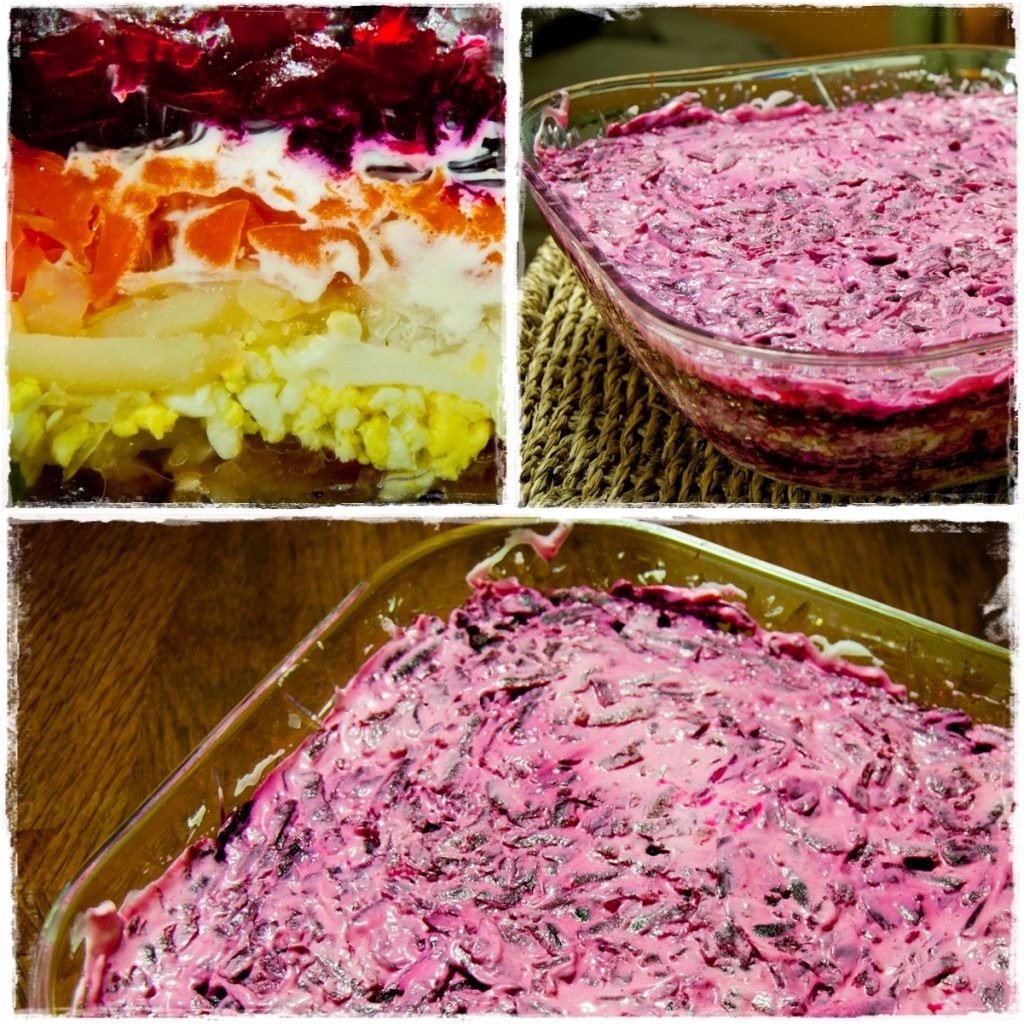
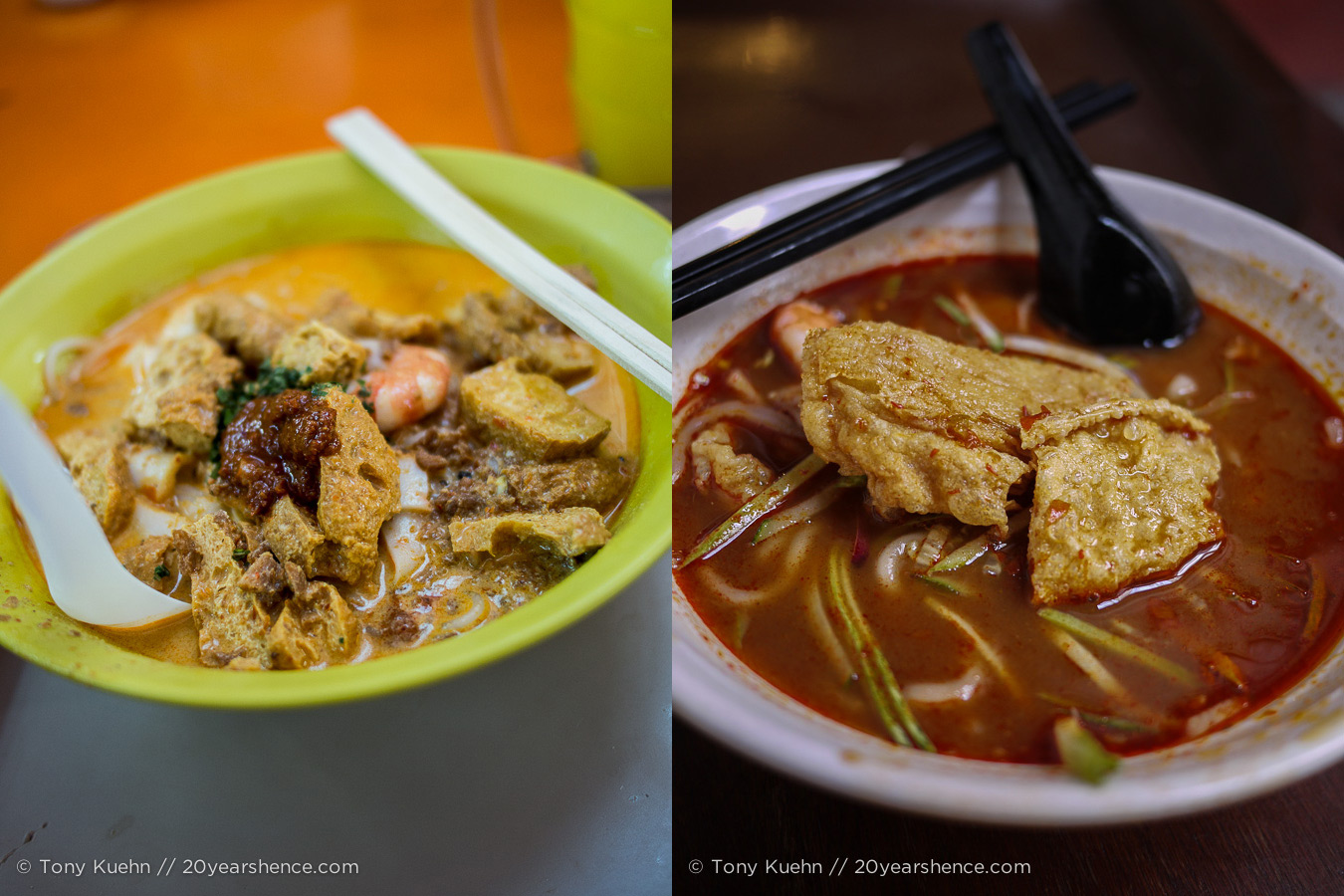
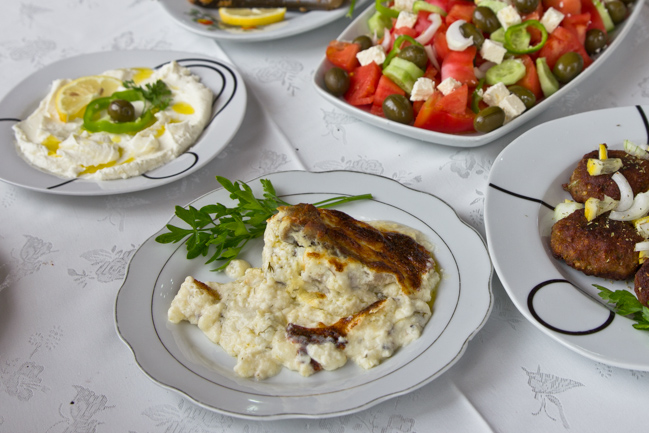
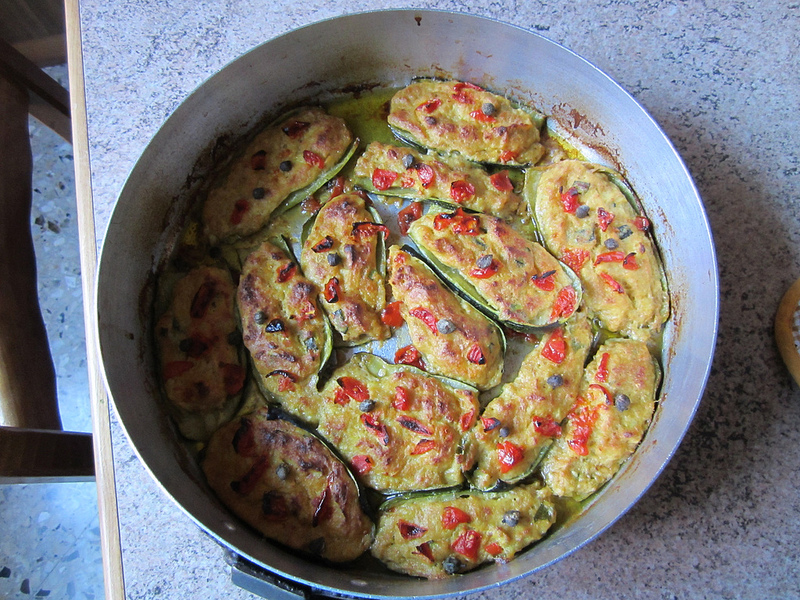
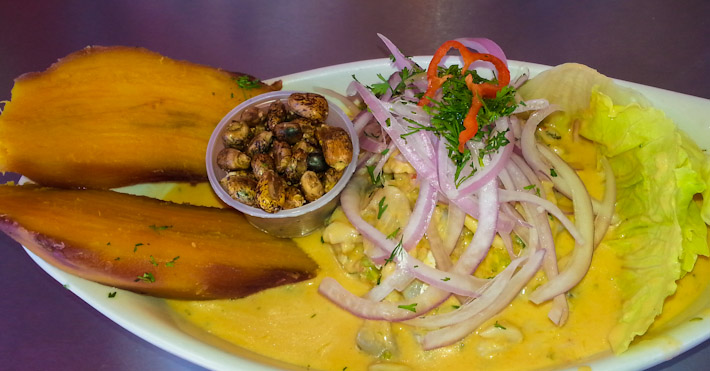
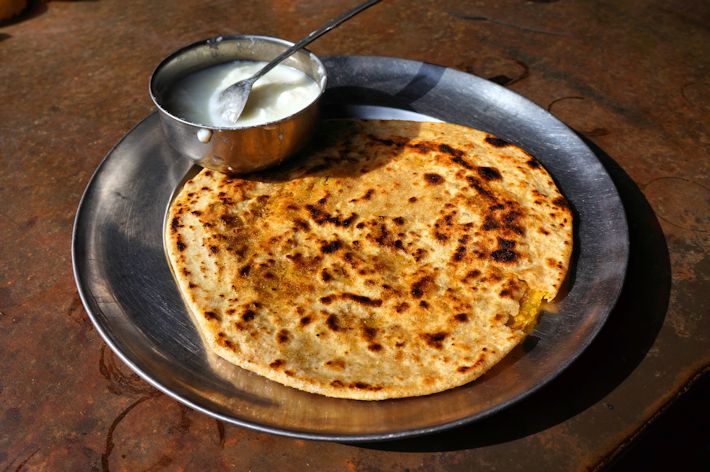

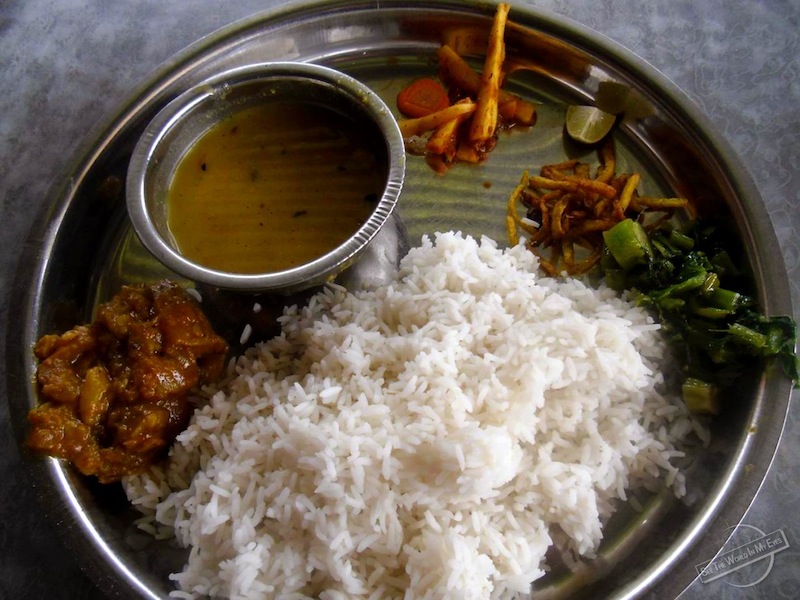
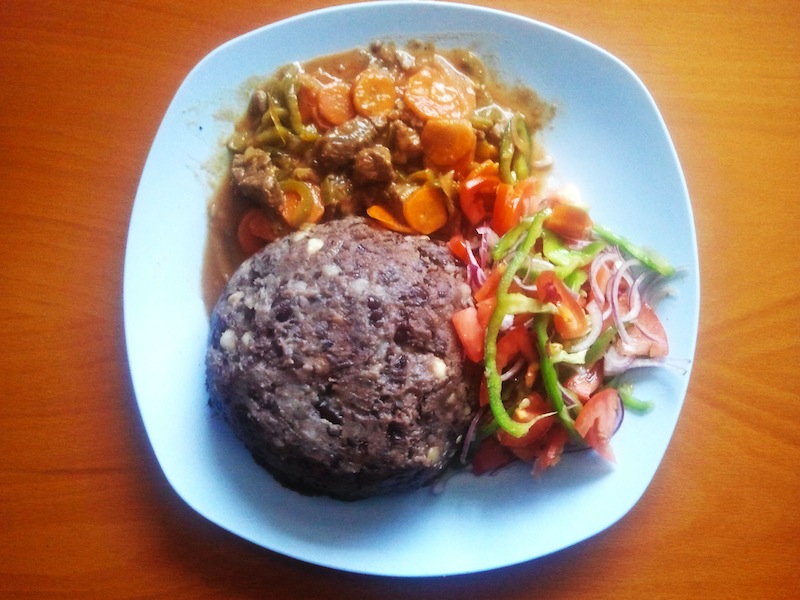
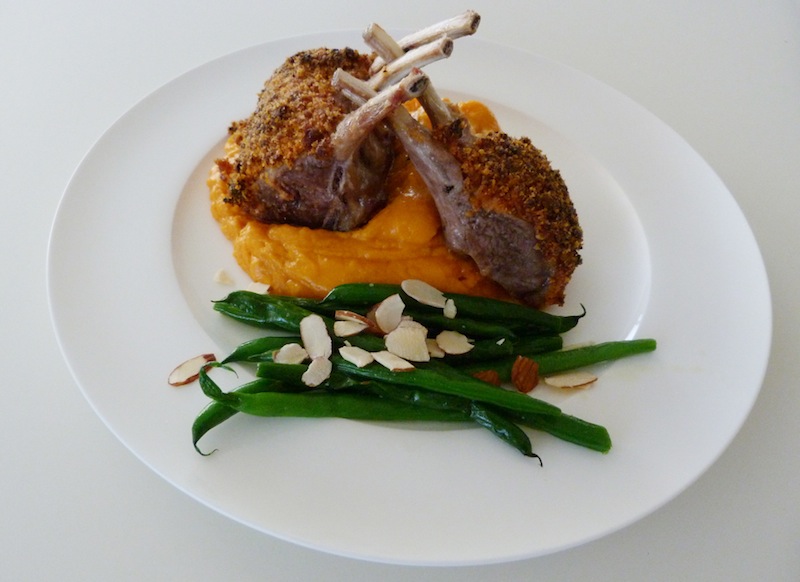

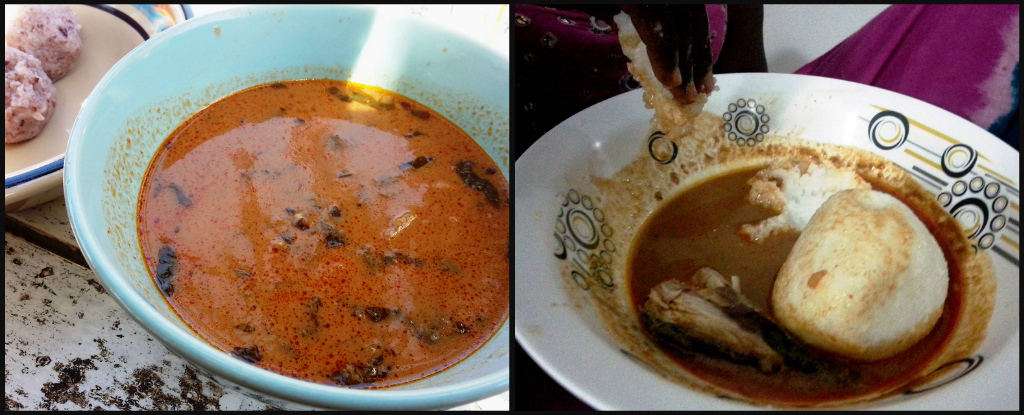

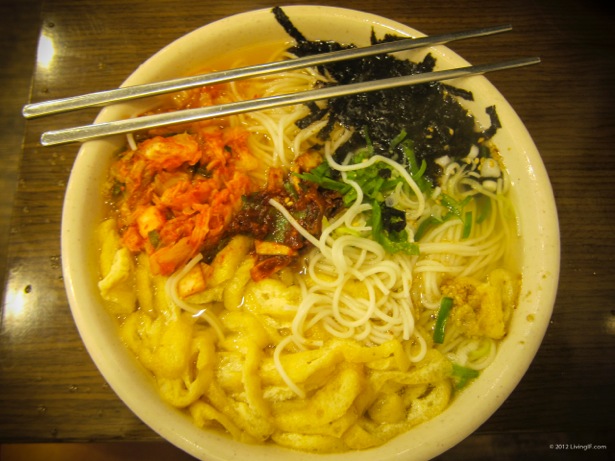
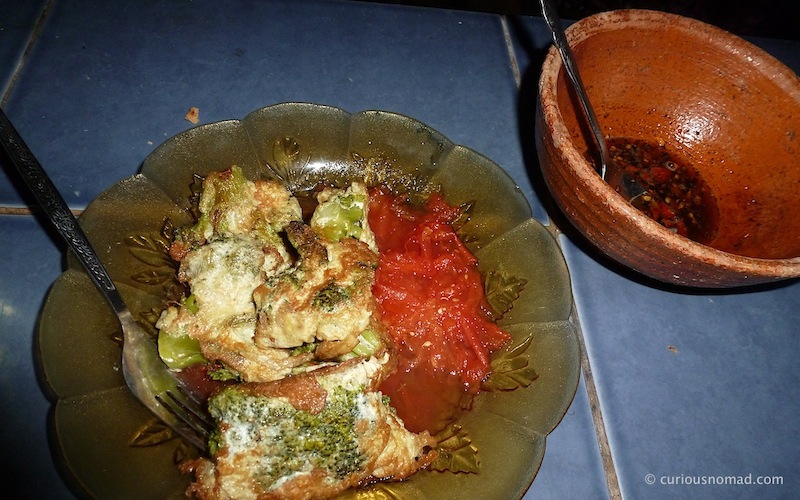

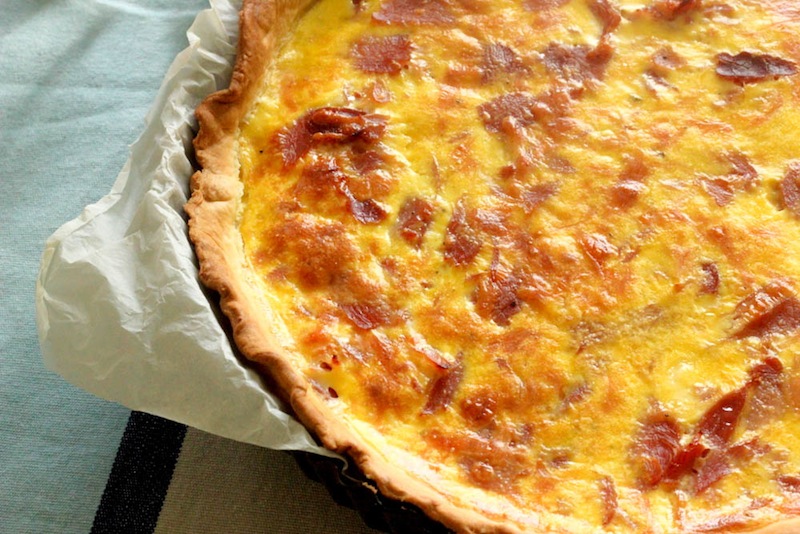
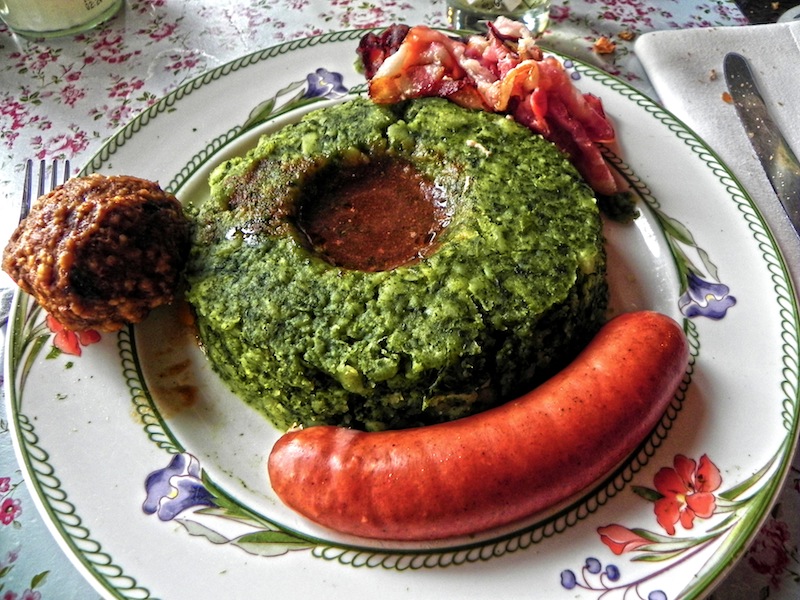
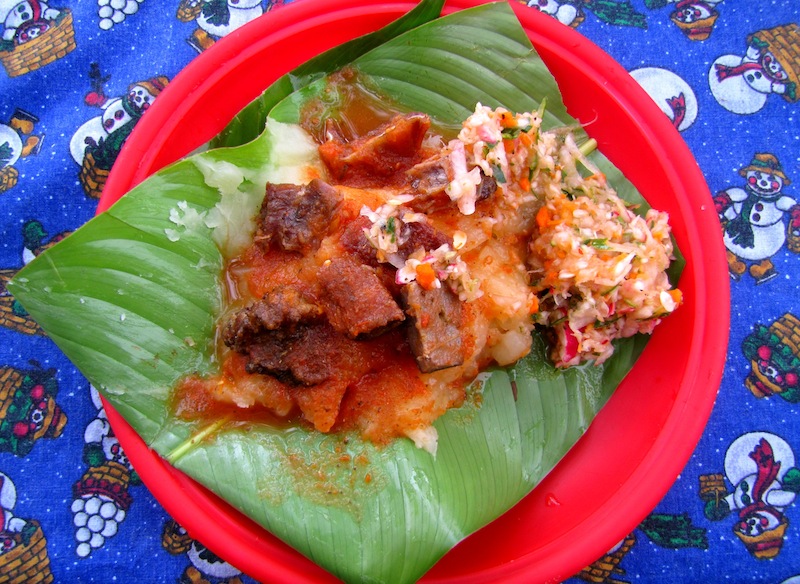
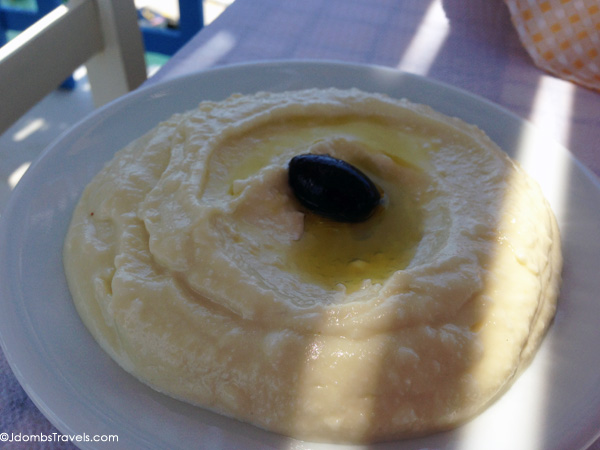

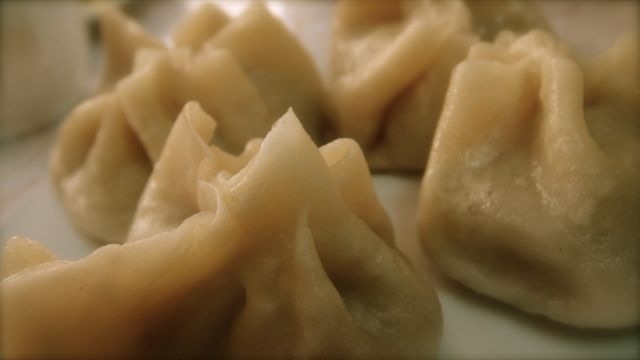

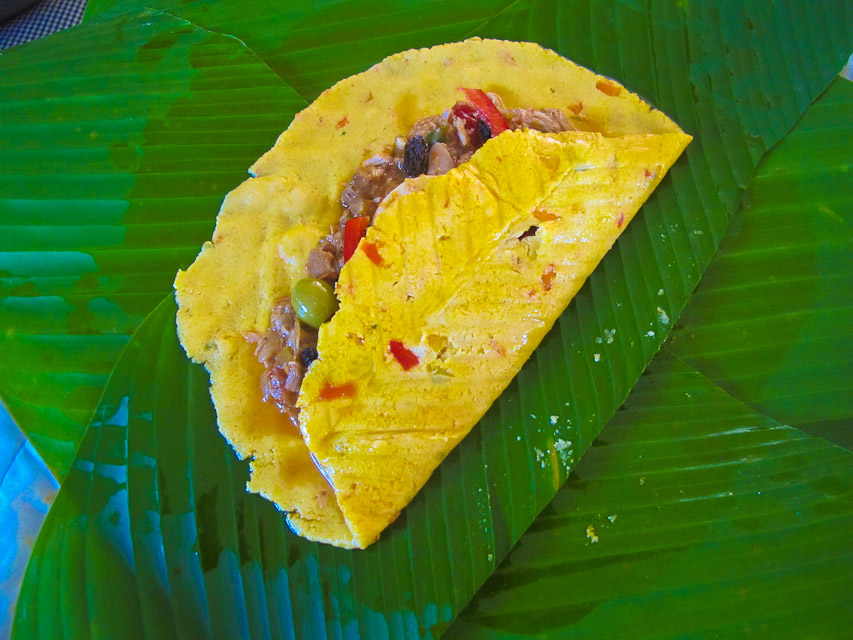

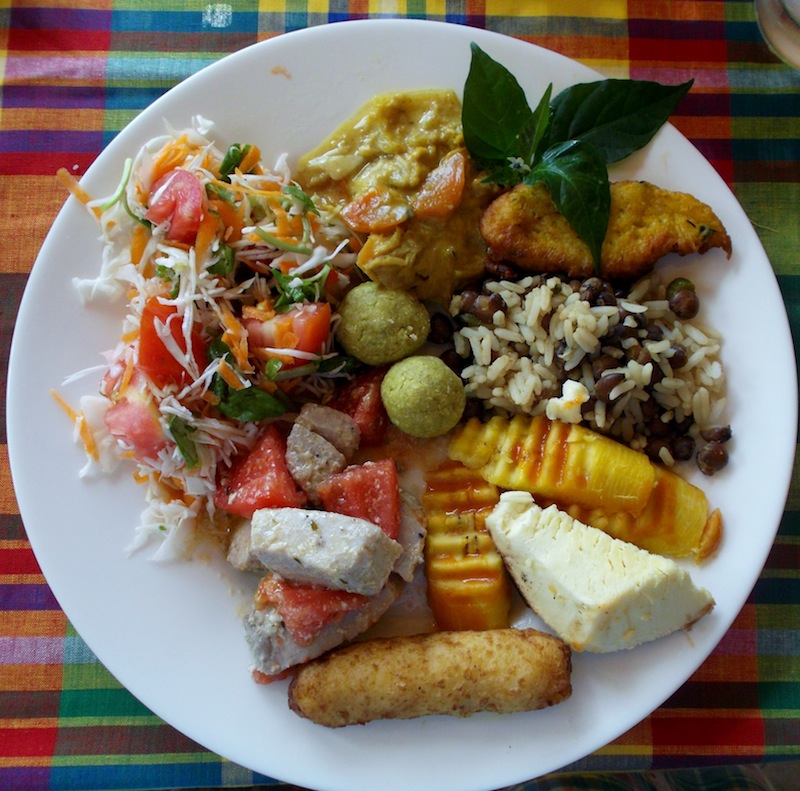
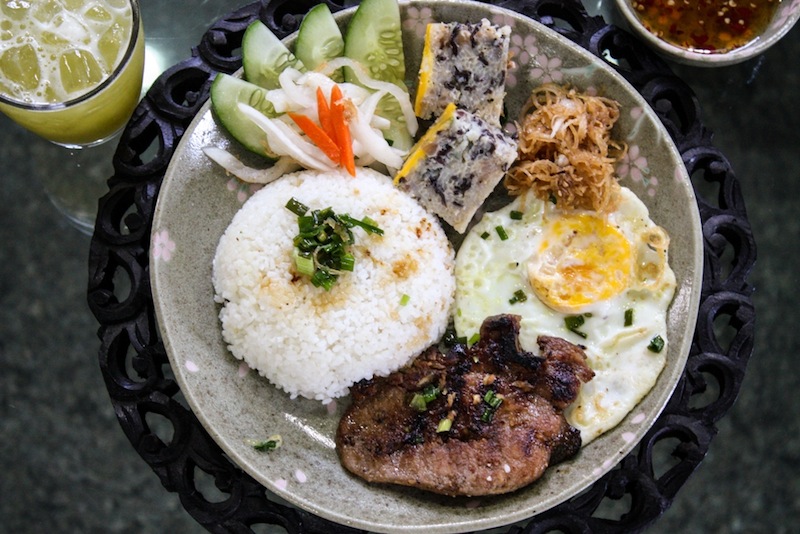

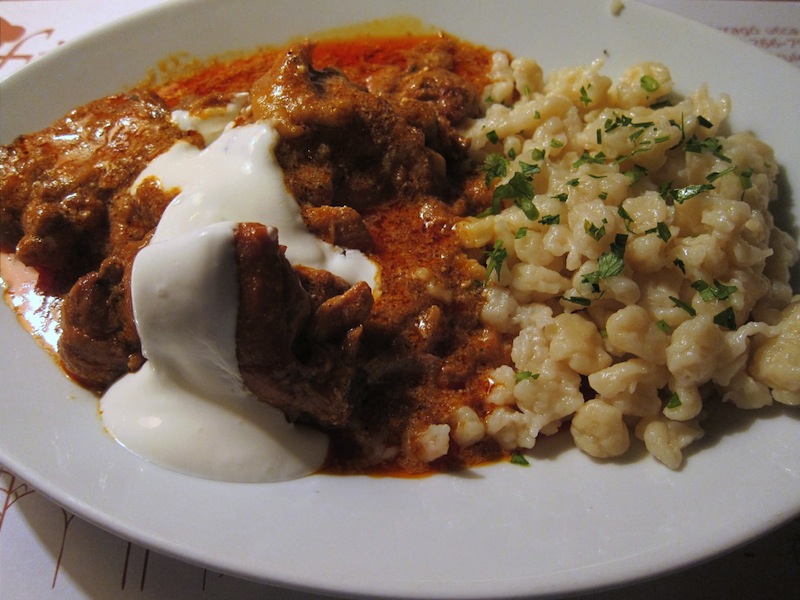
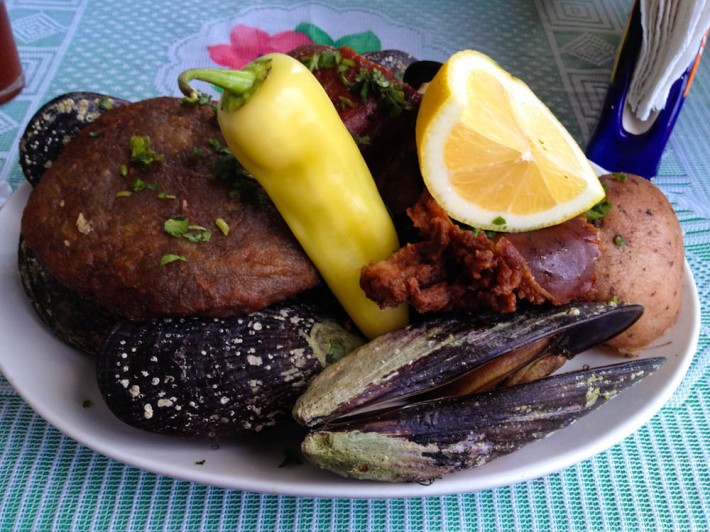
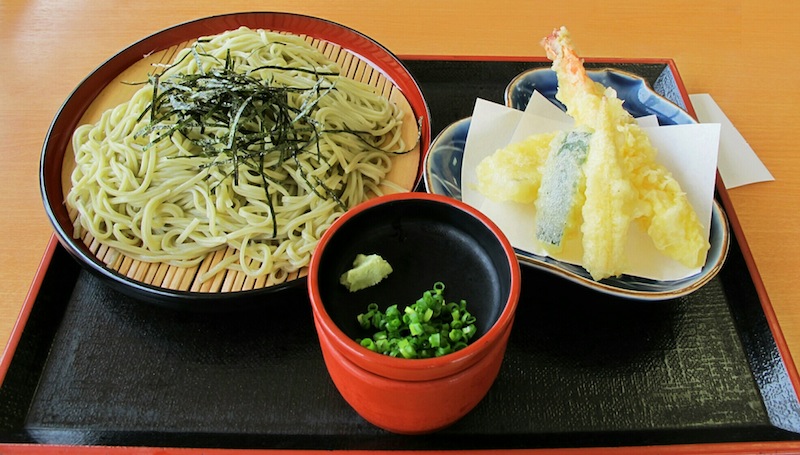
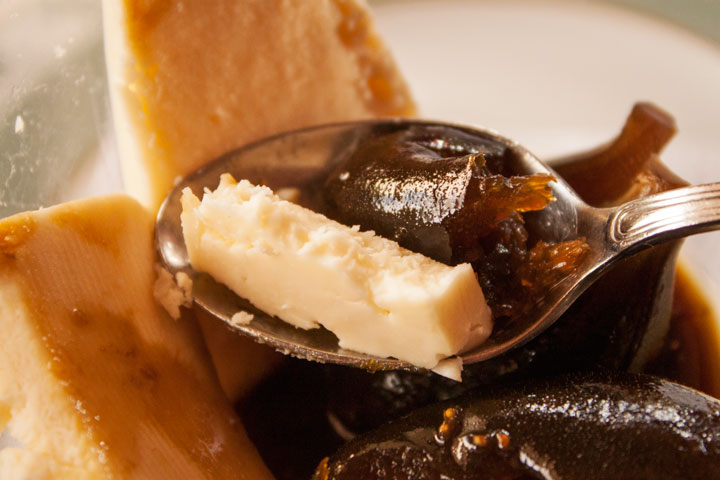
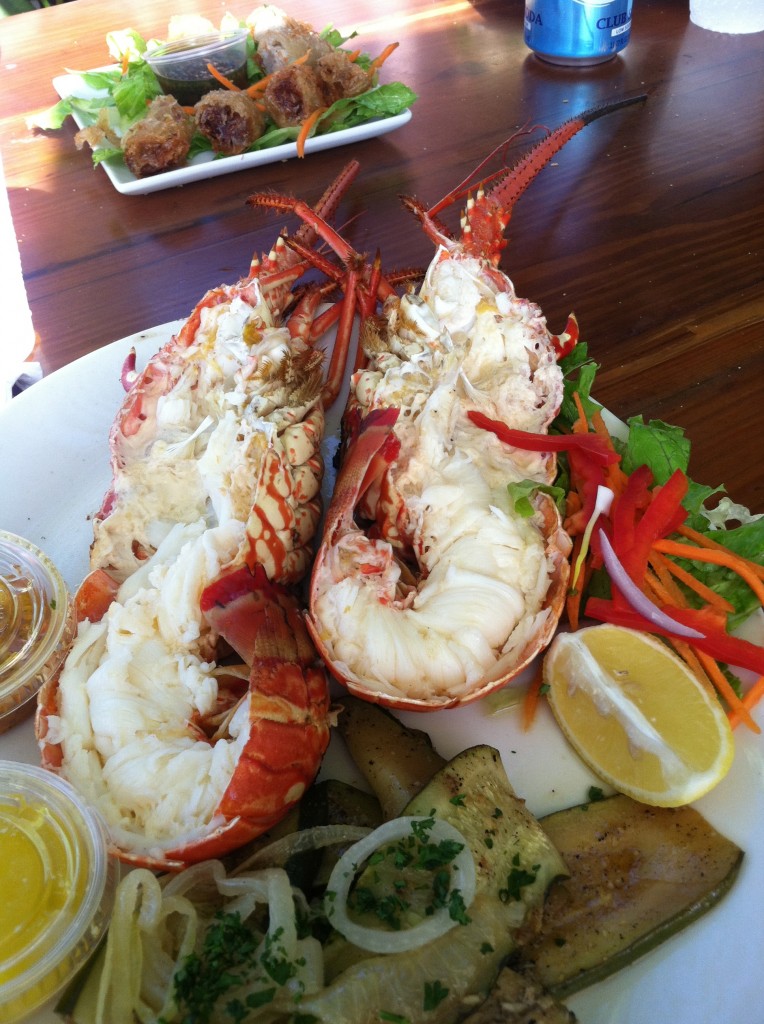

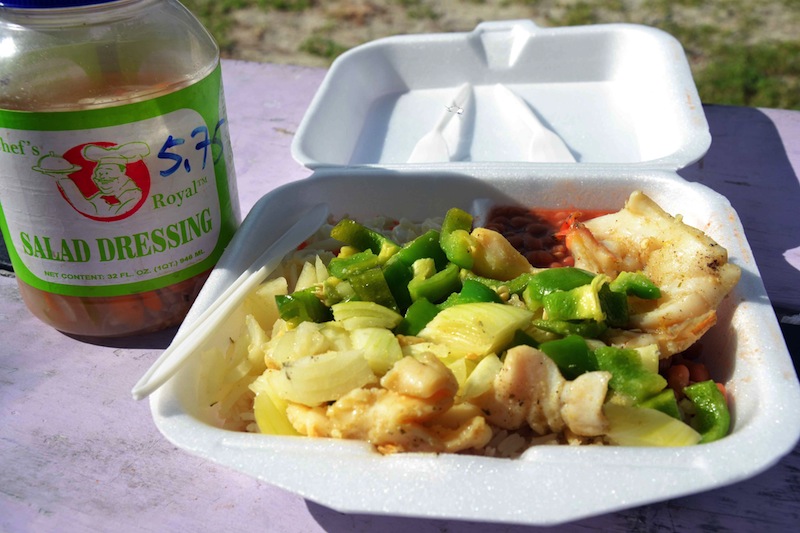

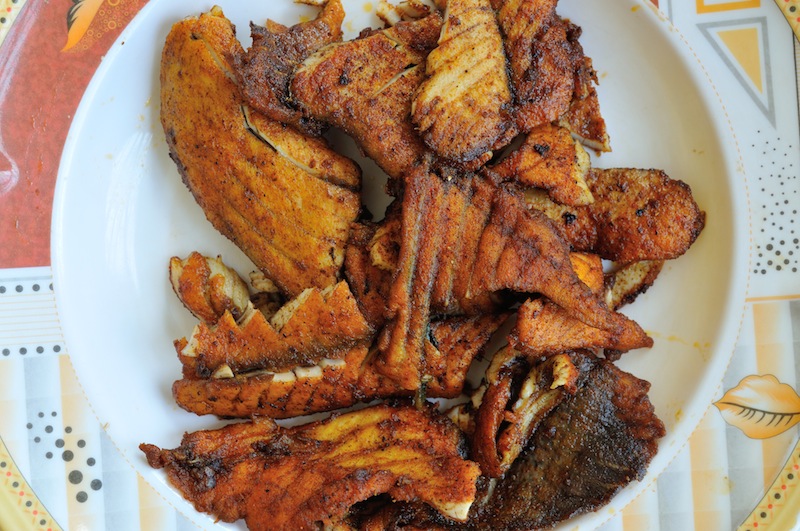




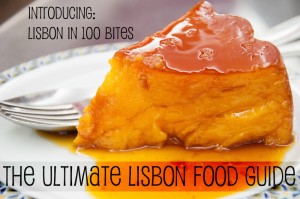
Wow Zara, that is another really delicious food compilation that makes hungry for more travels! Thanks for putting all these tasty looking dishes together and thank you even more for letting me contribute to it… :)
Thanks for being a part of this yummy post, Dennis! :)
Thanks for inviting me to contribute to this post :) So many delicious dishes again. I’ve had the Russian salad before without even knowing it’s Russian, haha.
Thanks for contributing with the Dutch dish, Vlad!
Next time we visit the Netherlands I shall look out for stamppot, as we did not come across it last time (unfortunately, I must say)!
Thanks Zara for organizing this round up! Incredible food, but have to say that my Portuguese Seafood Rice is by far the most appetizing Dish of the series!
Thank you for being a part of it, Nelson!
Well.. I am v-e-r-y partial to Portuguese food, so.. what can I say, right?! ;)
what a marvellous heart warminng list! nothing binds people of different cultures and countries more than food.
Thanks for featuring my write up about French Polynesian food. May we all travel with full hearts and contented stomachs!
Thanks Jean!
You are so right – nothing like food to connect people no matter where they come from!
FOOD PORN! YUM!!!! I still have to try that reindeer stew when I return to Finland! Thanks for the reminder :D
It sure looks exotic!
Would love to try it myself too!
This world sure does have a lot of tasty food – and I want to eat it all! Thanks so much for including me in this great round up :-)
Thanks for participating, Heather!
Awww FOOD.. that awesome excuse to keep on traveling to new places! ;)
This post makes me so hungry!
So you can imagine how I felt putting it all together!! :D
I love both of those articles, 1st and 2nd part! I’m a total foodie so it is like a little encyclopaedia for me :)
Glad you know you had fun reading the posts! :)
Thanks for having us on this amazing mouth-watering food article! :)
Thank you for contributing a “less obvious” dish from Italy. I thought I’d be pasta or pizza.. so thanks for surprising me! :)
Note to self: never read food related posts at 1am….. GREAT POST! I enjoying eating this post so much!
So… what did you end up having for breakfast?! ;)
OMG I am soooo hungry now! Thanks for asking us to be apart of this awesome article.
Thank you for being a part of it! :)
Thank you so much for featuring our Aussie entry. We have thoroughly enjoyed contributing as well as reading everyone else’s offerings. Brilliant idea and so interesting. Thanks guys :)
Thanks for your participation Guys!
We hope we get to come down to Australia and share an Aussie Barbie with you sometime!
wooow! All these dishes look soo good and also tasty. I want to try Russia Pad Shooboy, the Italian Stuffed Courgette and also the indian Aloo Paratha. Mmmm… Great article!
Thanks! Amongst so many yummy photos and food descriptions it’s hard to take a pick, I know! ;)
This collaboration is a great read for anyone who wants to enhance their motivation to travel and eat exotic food.
Thanks Mike!
Pingback: Three Cheers for Canadian Olympians in Sochi, Russia and Fantastic Creole Food in Dominica! « Ti Domnik Tales
Love this set of posts – it makes me want to travel even more…
Thanks for including Ecuador (our country) in the list. There is so much amazing food across the country.
Thanks for spreading the word about the good food of Ecuador, Bryan!
I often miss the tuna we had in Galapagos or the caldos during cold days in the Andes!
It was a bad idea to read this on an empty stomach! haha
Many thanks for including us in this post and introducing us to some awesome eats and new blogs to follow! :)
NEVER, never read “food porn” posts on an empty stomach!
There are always consequences!.. ;)
Great article, thanks for inviting me to be part of this awesome series.
Thanks for taking our food cravings all the way to Kenya, Rachel! :)
Hello guys,
Thanks for including my piece. Fantastic article.
We’ve been dreaming with going back to Central and South America ever since we were there a couple of years ago… thanks for making us want that EVEN MORE now!!! ;)
So many delicious looking dishes from around the world! I spot some of my favorites here too, like reindeer in Finland.
Thanks for including us!
Thanks for sending a taste of Greece across too!
I’ve read the whole post – I swear! – on an empty stomach. I’d kill for a Slovakian haluski right now! :-)
Slokavian Haluski sure looks good!
Pingback: #FOODPORN: Around the World in 80 Dishes, part ...
It was nice to learn about different food from this post. Mondongo from Bolivia is actually different from Mondongo in Colombia.
Interesting! What is the difference?
I was hoping it would be kamjatang for korea, but bibimbap is good :). This is going to be my go to food guide when I travel.
We’re happy to contribute to your travel/foodie inspiration! :)
Pingback: #FOODPORN: Around the World in 80 Dishes, part 1/2 | Backpack Me
Amazing series! I’m onto following :) It would be cool if you’ve added recipes to each dish too.
Thanks Elena.
And that’s actually a good idea – maybe for another upcoming post! :)
There is no better sort of porn than food porn…and this post is food porn at its finest ;) haha. I love the “Around the world in 80 dishes” concept. I love trying different types of cuisines and some of these I had never even heard of before. They will without a doubt be added to my foodie bucket list of dishes to try. Thanks for sharing! :)
Hi Marisa!
I am happy to read your foodie bucket list has grown after reading this post… that’s exactly what it was all about! :D
Pingback: Virgin Island Pick Up Salt Fish | Caribbean Eats!
Pingback: Boba Tea Smoothie | Boba Tea™
I miss India… and aloo paratha :)
anyway, great article. well done!
Oh man… we miss aloo paratha too!
Good thing we’re going to India in 3 days! ;)
Pingback: Published Works - Contented Traveller | Contented Traveller